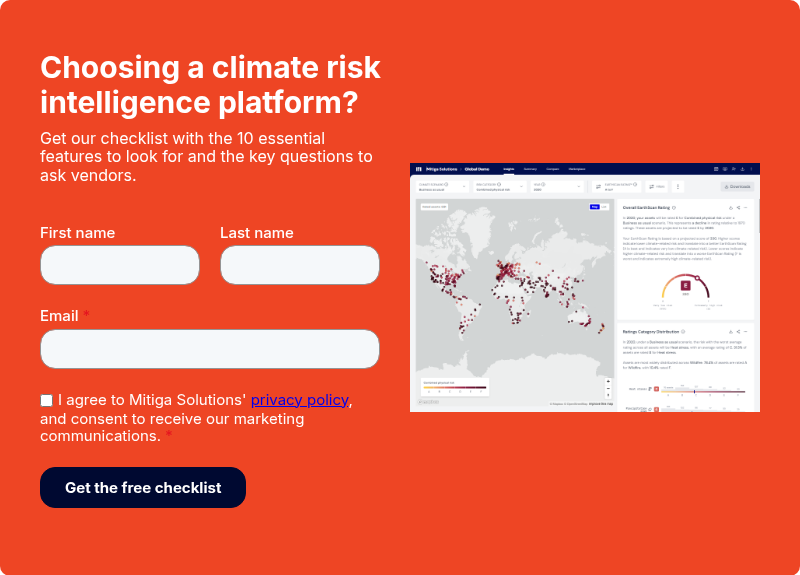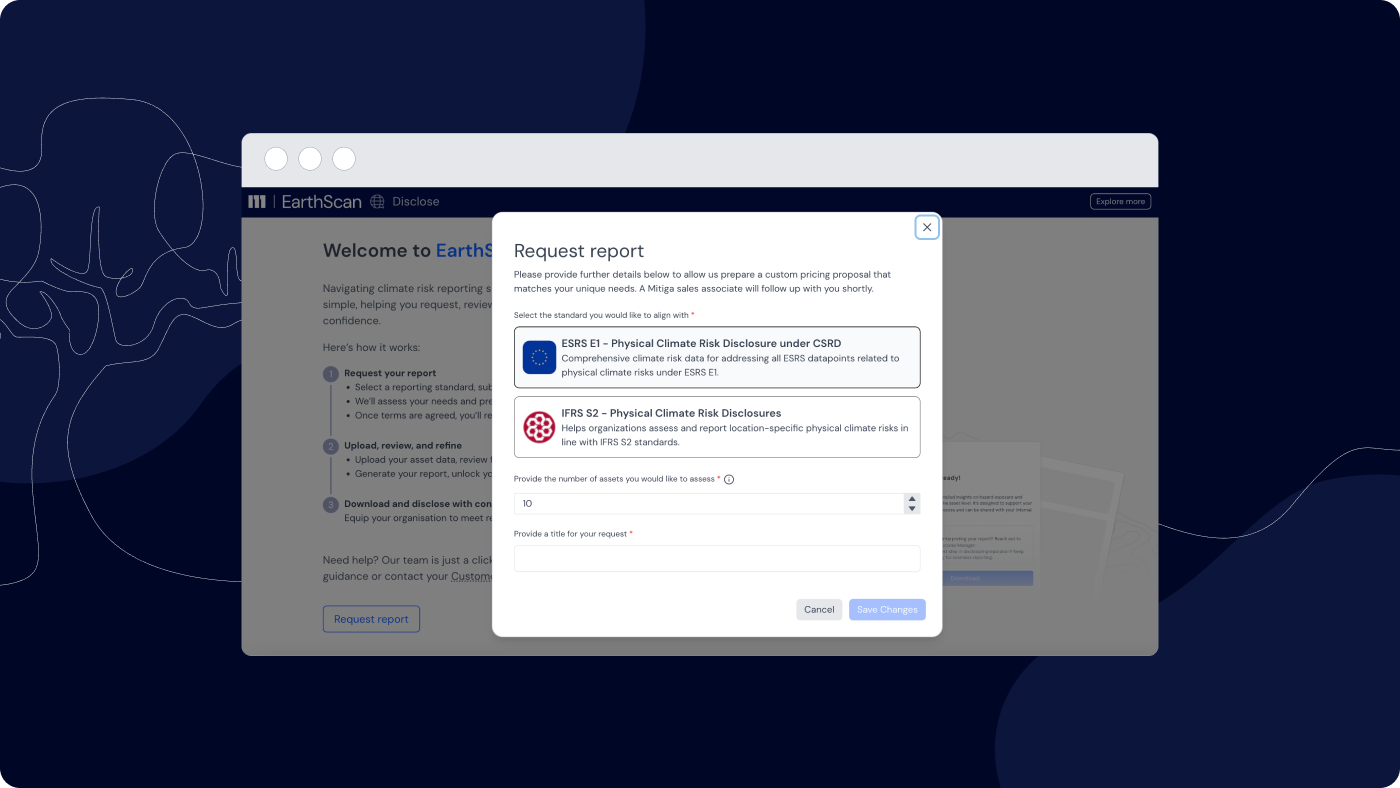The insurance industry has already witnessed losses as a result of a changing climate. In 2023, economic losses derived from natural disasters totalled USD 380 billion.
Out of those losses, only 31% were assets covered by insurance. This data reflects a considerable protection gap between insured assets and those assets impacted by climate change and natural disasters.
The Maui wildfires of 2023 incurred insurance losses between $2.5 billion to $4.5 billion. In the first half of that same year, The Wall Street Journal reported thunderstorms as accountable for 70% of insured losses in the US.
In an ever-warming world, one where the impacts of climate change will become more and more visible, the insurance industry finds itself at the crossroads of risk and resilience, with climate change becoming a defining factor for insurers working to protect individuals and businesses.
Protection Gap by Peril in 2023

The role of insurance in a warming world
Insurance plays a vital role in offering financial protection to individuals and communities dealing with the escalating impacts of climate change.
For individuals, insurance serves as a crucial safety net, covering the costs of property damage, loss of belongings, and temporary housing in the aftermath of climate-related events. This not only eases the financial burden on households but also accelerates the recovery process, allowing individuals to rebuild their lives.
On a larger scale, insurance facilitates community resilience by supporting the reconstruction of infrastructure, restoration of public services, and recovery of businesses.
Swiss Re reports that while 85% of severe convective storm losses occurred in the U.S., they are growing the fastest in Europe, exceeding USD 5 billion annually for the past three years. Notably, nine out of the top ten disasters were linked to climate change, with 63 of 66 major events in 2023 being caused by weather.
Escalating frequency and severity of extreme weather events contribute to increased claims and payouts, challenging insurers to accurately assess and price evolving risks. It does not help that insurance companies struggle with the challenge of accurately assessing the risks associated with insuring properties in vulnerable areas.
In a recent feature on InsTech podcast, Jonathan Liddell, our Customer Success Lead at Mitiga, highlighted the limitations of traditional catastrophe modeling in the context of climate change:
“Previously catastrophe modeling has been about predicting the future based on historical events. But you cannot predict the future of climate change based on historical events, basically by the nature of climate change. There are going to be multiple different scenarios, as there are multiple different inputs. It’s very difficult to be able to ascertain what the future will hold. When it comes to natural catastrophes, not including climate change in your analysis could potentially mean a loss of millions for your assets.”
Despite the growing threat of climate change, only around a quarter of the total economic losses caused by extreme weather and climate-related events are insured. This insurance protection gap is the urgent need to integrate climate risk assessment tools in the insurance industry.
As climate-related risks continue to intensify, this protection gap will only widen unless insurers and policymakers take proactive steps.
By leveraging climate risk assessment tools such as EarthScan, the industry can play a pivotal role in closing this gap, ensuring that individuals, businesses, and communities are better protected against the escalating impact of climate risks.
The role of insurance in climate resilience
The insurance industry plays an important role in addressing climate change by making society and the economy more climate resilient. Insurers encourage businesses and individuals to take action to reduce their climate risks.
For instance, by offering lower premiums to policyholders implementing climate-related adaptation measures. These measures, such as anti-flood doors or early warning systems, could reduce the policyholder’s physical risk exposures and consequently reduce their insurance claims.
While insurers currently face challenges from frequent climate-related disasters, this situation presents an opportunity for them to build more resilient and responsive businesses. Insurers that proactively address climate risks stand better positioned to ensure financial stability, protect policyholders, and contribute to global economic resilience.
However, the Climate Council report found that inaccessible information on natural hazard risk is one of the main reasons insurers are not ready to take on the challenge, and only with a more accurate view of potential risks in different warming scenarios can insurers protect their assets that answer the needs of individuals, communities, and businesses at the same time.
Accessible climate science can help insurers and their clients
Accessible climate science is the foundation upon which insurers can build robust risk models and develop innovative insurance products.
It provides the necessary data to assess potential liabilities associated with climate-related events and adapt to the changing landscape. As Wiebke Cundill, Senior Risk Engineer at HDI Global SE, notes:
“The data and the way we get it from Mitiga is a perfect fit. We have in the past, and we're still using it for assessing exposures, for portfolio modeling, for premiums and everything. We have our in-house tool, and we have natural hazards data there, but it's based on historical events, on historical data. And what Mitiga does for us now is basically they click onto that almost like a puzzle piece, and with them, we can say, this is our data from the past. This is the historical data status now, and Mitiga helps us to go forward into the future.”
Climate risk platforms like EarthScan provide insurers with the ability to access data and get critical insight into risks such as flooding, droughts, and extreme temperatures in only a few seconds.
This enables rapid assessment of climate risk across portfolios, allowing insurers to understand their exposure from the present day to the end of the century under various climate scenarios. EarthScan quantifies the financial impact, translating climate risks into potential costs, and enabling more precise pricing and risk management .
Jonathan Liddell underscores the importance of EarthScan in understanding and preparing for climate risks:
“It’s about helping people get ahead of the game, especially in the financial world, when you're investing or you're looking at insuring assets, you want to make sure that climate change is a part of your analysis over the lifespan of your investment or your insurance period.”
With tools such as EarthScan, insurers can easily calculate and integrate climate risks into their decision-making processes. As Wiebke explains:
“All we need, basically, is the location in the world. That's really the starting point at the beginning. That's what I always say, you don't need to do much more, give us your sight, then with the help of EarthScan and material, we do the screening for the exposures."
Accessible climate science empowers insurers to proactively engage in risk mitigation and resilience-building efforts. By leveraging climate data, insurers can also collaborate with communities, businesses, and policymakers to develop strategies that reduce vulnerability to climate-related risks.
This not only helps insurers in minimizing potential losses but also contributes to the overall stability of the insurance market. Additionally, insurers can play a pivotal role in promoting sustainable practices by encouraging clients to adopt climate-resilient measures.
Ultimately, accessible climate science is a cornerstone for insurers to navigate the challenges posed by climate change, make informed decisions, and contribute to the broader societal goal of building a more resilient and sustainable future.
The insurance industry has already witnessed losses as a result of a changing climate. In 2023, economic losses derived from natural disasters totalled USD 380 billion. Out of those losses, only 31% were assets covered by insurance. This data reflects a considerable protection gap between insured assets and those assets impacted by climate change and natural disasters.





